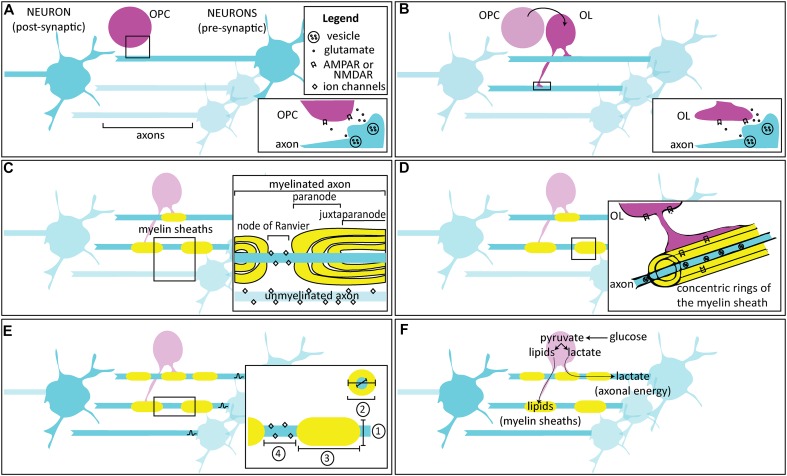FIGURE 1.
Activity-dependent myelination. (A) Oligodendrocyte progenitor / precursor cells (OPCs) are found in the developing circuit alongside neurons, and are thought to interact through glutamatergic signaling. Inset: Following an action potential, glutamate released from the axon is thought to bind to AMPARs and NMDARs on OPCs, either at a synapse or extrasynaptically. (B) OPCs differentiate into oligodendrocytes (OLs), which also interact with neurons in the developing circuit. Inset: Following an action potential, glutamate released from the axon is thought to bind to AMPARs and NMDARs on OLs, either at the axomyelinic synapse or extrasynaptically. (C) OLs enwrap concentric myelin sheaths around axons. One OL can enwrap multiple axons, while individual myelin sheaths along the same axon are wrapped by different OLs. The most important factor for myelin initiation is axon diameter, but neuronal activity may bias axon selection. Inset: In unmyelinated fibers, ion channels are distributed throughout the axon. Myelin ensheathment prevents current leakage by restricting ion flow primarily to particular, unmyelinated regions called the nodes of Ranvier. Immediately adjacent to the nodes are regions called paranodes, where the myelin loops contact the axons, and the regions further interior are called the juxtaparanodes. Nodes, paranodes, and juxtaparanodes are enriched with specific proteins to support their structural composition and function. (D) Over time, the concentric sheaths become compact myelin. In the adaptive myelination phase, changes to the extant myelin may occur in an activity-dependent manner. Inset: Glutamatergic receptors may be found within the sheathes themselves, where they are thought to respond to vesicular release and allow for myelinic calcium influx. (E) By varying the conduction velocity of the action potential, myelination can influence the arrival of axonal spikes, acting as a mechanism for regulating precise timing and synchrony in circuits. Mature, more myelinated circuits show inter- and intra-axonal variation in conduction velocity, depending on four factors (inset):  the axon diameter,
the axon diameter,  the myelin thickness, measured by g-ratio: a ratio of the inner to the outer diameter of the sheath,
the myelin thickness, measured by g-ratio: a ratio of the inner to the outer diameter of the sheath,  the length of continuous axonal segment that is wrapped, or the internode distance, and
the length of continuous axonal segment that is wrapped, or the internode distance, and  the node itself, including its geometry, and the composition and number of ion channels. (F) Other than plasticity, activity-dependent myelination is also thought to be important in maintaining circuits. Neuronal activity is detected by receptors in axons and cells of the OL lineage, which use their metabolites for maintenance of the myelin sheaths (e.g., through lipid synthesis) or for providing metabolic support (e.g., by shuttling lactate). This likely corresponds with a development switch in OLs from an earlier mode of myelin formation that utilizes mitochondrial-dependent aerobic respiration to a later, glycolysis-dependent mode that meets the energy demands for survival of the OL and of the associated axon especially during periods of increased activity.
the node itself, including its geometry, and the composition and number of ion channels. (F) Other than plasticity, activity-dependent myelination is also thought to be important in maintaining circuits. Neuronal activity is detected by receptors in axons and cells of the OL lineage, which use their metabolites for maintenance of the myelin sheaths (e.g., through lipid synthesis) or for providing metabolic support (e.g., by shuttling lactate). This likely corresponds with a development switch in OLs from an earlier mode of myelin formation that utilizes mitochondrial-dependent aerobic respiration to a later, glycolysis-dependent mode that meets the energy demands for survival of the OL and of the associated axon especially during periods of increased activity.

